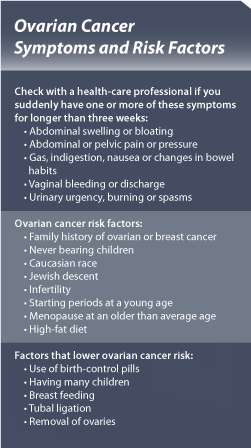Listening For A Silent Killer
Symptoms suggest a closer look for ovarian cancer
Most people know ovarian cancer as a silent killer. It's an often-deadly disease that strikes with little warning. However, a study by researchers in the UW Department of Obstetrics and Gynecology shows that women may have far more warning about the onset of the disease than previously thought.
The study, conducted by the UW's Dr. Barbara Goff and Dr. Lynn Mandel with a colleague at Virginia Mason Medical Center, was published in the June 9, 2004 issue of the Journal of the American Medical Association.
The researchers surveyed a group of more than 1,800 women, including 128 women who had been diagnosed with ovarian masses. The women were asked about their previous year's symptoms, and asked to rate the severity, duration, and frequency of those symptoms. Researchers found that women with ovarian cancer typically experienced abdominal symptoms common to healthy women, but experienced them more often, more recently, and with much more severity.
 |
| A woman undergoes surgery to remove her ovaries.The woman had participated in a UW study of early indicators of ovarian cancer, which often goes undetected until it is incurable. |
Women with cancer most often reported bloating, increased abdominal size, fatigue, urinary urgency, abdominal pain, and pelvic pain, all of which are fairly common among all women. However, compared to women in the control group, those with cancer were far more likely to have the symptoms, and in greater number.
The frequency and onset of the symptoms were important clues, as well. Women with cancer reported symptoms occurred 20 to 30 times per month, and with more severity and more recent onset than women without cancer reported. A combination of bloating, increased abdominal size, and urinary problems was found in 43 percent of women with cancer, but in only 8 percent of women in the control group.
Because the symptoms are so common among even healthy women, the researchers stressed that women and their health-care providers should discuss unusual and frequent clusters of symptoms.
"Women should listen to their bodies and discuss concerns with their health-care providers," said Dr. Goff.
The researchers are continuing to study early symptoms of ovarian cancer. They hope to find trends in the survey data that could help better identify patients with cancer. They are working with Dr. Martin McIntosh, a biostatistician at the Fred Hutchinson Cancer Research Center and a research associate professor in the UW School of Public Health and Community Medicine, to develop an algorithm that fits the survey data on women's symptoms.
 |
"Ultimately what we're trying to do is get enough pilot data to develop an evaluative cancer index," said Goff. "Women would come in and fill out a survey on family history, age, and other factors, and we could individualize a symptom index and determine if a woman is at risk."
Such an index could help identify ovarian cancer much earlier, which may boost survival among women with the disease.
Every year, approximately 23,000 women are diagnosed with ovarian cancer, and 14,000 women die of the disease. One reason for the relatively high fatality rate is failure to identify early-stage disease. The identification of early symptoms is important because five-year survival for early-stage disease is 70 percent to 90 percent, compared with 20 to 30 percent for advanced-stage disease.

Dr. Barbara Goff
